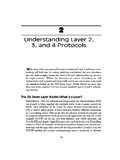Transcription of CHAPTER FOUR OSI Model and Network Protocols
1 4 CHAPTER FOUROSI Model and the function of common networking (S). (VoIP).RTP (VoIP). 4: OSI Model and Network the function of each layer of the OSI 1 2 data 3 4 5 6 7 applicationWhat You Need To the seven layers of the OSI the function of each layer of the OSI the layer at which networking devices the function of various networking of the most important networking concepts to understand is the OpenSystems Interconnect (OSI)reference Model . This conceptual Model , created bythe International Organization for Standardization (ISO)in 1978 and revised in1984, describes a Network architecture that allows data to be passed betweencomputer CHAPTER looks at the OSI Model and describes how it relates to real-worldnetworking.
2 It also examines how common Network devices relate to the OSImodel. Even though the OSI Model is conceptual, an appreciation of its purposeand function can help you better understand how protocol suites and networkarchitectures work in practical OSI Seven-Layer ModelAs shown in Figure , the OSI reference Model is built, bottom to top, in thefollowing order: physical, data link, Network , transport, session, presentation,and application. The physical layer is classified as Layer 1, and the top layer ofthe Model , the application layer, is Layer OSI Seven-Layer Model135 FIGURE OSI seven-layer ALERTOn the Network + exam, you might see an OSI layer referenced either by its name,such as data link, or by its layer number.
3 For instance, you might find that a router isreferred to as a Layer 3 layer of the OSI Model has a specific function. The following sectionsdescribe the function of each layer, starting with the physical layer and workingup the Layer (Layer 1)The physical layer of the OSI Model identifies the Network s physical character-istics, including the following specifications:.Hardware: The type of media used on the Network , such as type ofcable, type of connector, and pinout format for : The physical layer identifies the topology to be used in thenetwork. Common topologies include ring, mesh, star, and addition to these characteristics, the physical layer defines the voltage used ona given medium and the frequency at which the signals that carry the data oper-ate.
4 These characteristics dictate the speed and bandwidth of a given medium,as well as the maximum distance over which a certain media type can be - Application6 - Presentation5 - Session4 - Transport3 - Network2 - Data-link1 - Physical136 CHAPTER 4: OSI Model and Network ProtocolsData Link Layer (Layer 2)The data link layer is responsible for getting data to the physical layer so that itcan be transmitted over the Network . The data link layer is also responsible forerror detection, error correction, and hardware addressing. The term frameisused to describe the logical grouping of data at the data link data link layer has two distinct sublayers:.Media Access Control (MAC) layer: The MAC address is defined atthis layer.
5 The MAC address is the physical or hardware address burnedinto each Network interface card (NIC). The MAC sublayer also controlsaccess to Network media. The MAC layer specification is included in theIEEE Link Control (LLC) layer: The LLC layer is responsible forthe error and flow-control mechanisms of the data link layer. The LLClayer is specified in the IEEE Layer (Layer 3)The primary responsibility of the Network layer is routing providing mecha-nisms by which data can be passed from one Network system to another. Thenetwork layer does not specify how the data is passed, but rather provides themechanisms to do so. Functionality at the Network layer is provided throughrouting Protocols , which are software at the Network layer are also responsible for route selection, which refersto determining the best path for the data to take throughout the Network .
6 Incontrast to the data link layer, which uses MAC addresses to communicate onthe LAN, Network layer Protocols use software configured addresses and specialrouting Protocols to communicate on the Network . The term packetis used todescribe the logical grouping of data at the Network added manually toEXAM ALERTthe routing tables. In a dynamic routing environment, routing Protocols such as RoutingInformation Protocol (RIP)and Open Shortest Path First (OSPF)are used. These protocolscommunicate routing information between networked devices on the Network . When working with networks, routes can be configured in two ways: staticallyordynamically. In a static routing environment, routes are added manually to the routingtables.
7 In a dynamic routing environment, routing Protocols such as RoutingThe OSI Seven-Layer Model137 Information Protocol (RIP)and Open Shortest Path First (OSPF)are used. These proto-cols communicate routing information between networked devices on the Layer (Layer 4)The basic function of the transport layer is to provide mechanisms to transportdata between Network devices. Primarily it does this in three ways:.Error checking: Protocols at the transport layer ensure that data is sentor received addressing: Protocols such as TCP/IP support many networkservices. The transport layer makes sure that data is passed to the rightservice at the upper layers of the OSI : To traverse the Network , blocks of data need to be bro-ken into packets that are of a manageable size for the lower layers tohandle.
8 This process, called segmentation, is the responsibility of thetransport at the Transport LayerProtocols that operate at the transport layer can either be connectionless, suchas User Datagram Protocol (UDP) , or connection-oriented, such as TransmissionControl Protocol (TCP). For a further discussion of these Protocols , and of the dif-ference between connection-oriented and connectionless Protocols , refer to thelater section Connectionless and Connection-Oriented Protocols . Flow ControlThe transport layer is also responsible for data flow control, which refers to howthe receiving device can accept data transmissions. Two common methods offlow control are used:.Buffering: When buffering flow control is used, data is temporarilystored and waits for the destination device to become available.
9 Bufferingcan cause a problem if the sending device transmits data much fasterthan the receiving device can manage : In a windowing environment, data is sent in groups of seg-ments that require only one acknowledgment. The size of the window(that is, how many segments fit into one acknowledgment) is definedwhen the session between the two devices is established. As you canimagine, the need to have only one acknowledgment for every, say, fivesegments can greatly reduce 4: OSI Model and Network ProtocolsSession Layer (Layer 5)The session layer is responsible for managing and controlling the synchroniza-tion of data between applications on two devices. It does this by establishing,maintaining, and breaking sessions.
10 Whereas the transport layer is responsiblefor setting up and maintaining the connection between the two nodes, the ses-sion layer performs the same function on behalf of the Layer (Layer 6)The presentation layer s basic function is to convert the data intended for orreceived from the application layer into another format. Such conversion is nec-essary because of how data is formatted so that it can be transported across thenetwork. Applications cannot necessarily read this conversion. Some commondata formats handled by the presentation layer include the following:.Graphics files: JPEG, TIFF, GIF, and so on are graphics file formatsthat require the data to be formatted in a certain and data: The presentation layer can translate data into differentformats, such as American Standard Code for Information Interchange(ASCII) and Extended Binary Coded Decimal Interchange Code(EBCDIC).










